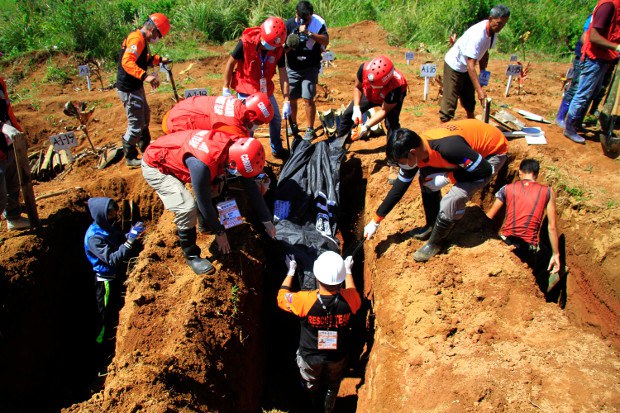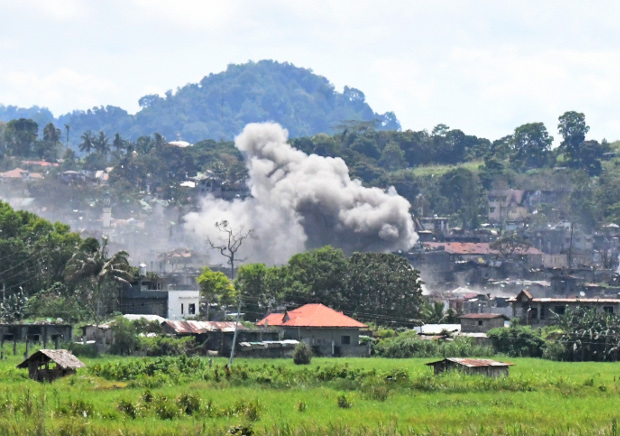Philippines: US to provide $15 million for Recovery, Rehabilitation of Marawi
2017.09.05
Marawi, Philippines
 Government workers bury unidentified and unclaimed remains at a public cemetery in the southern Philippine city of Marawi, Sept. 5, 2017.
Government workers bury unidentified and unclaimed remains at a public cemetery in the southern Philippine city of Marawi, Sept. 5, 2017.
The United States announced Tuesday it was providing the Philippines with 730 million pesos (U.S. $15 million) in fresh assistance to support relief and rehabilitation efforts in the southern city of Marawi, where the military said the battle to flush out Islamic State-linked militants was in its final stages.
Officials said a portion of that amount would be spent on relief supplies, including safe drinking water, hygiene kits and shelter materials, for tens of thousands of people who were displaced when militants attacked Marawi, more than 700 miles south of Manila, on May 23.
“We all look forward to the end of the crisis, and the end of the fighting and suffering,” U.S. Ambassador Sung Kim told reporters in Manila. “We have been and will continue to support the Philippine government’s efforts to deal with the crisis.”
Most of the funds, Kim said, would support long-term rehabilitation programs for Marawi, parts of which have been reduced to rubble by airstrikes targeted at the militants who have entrenched themselves in buildings in the heart of the lakeside city.
Small numbers of U.S. and Australian troops have been helping their Filipino counterparts gather intelligence against the militants, though they are barred from actual combat.
The fighting has killed 641 militants, 145 soldiers and 45 civilians, military officials said Tuesday.
Kim said the donation represented a part of Washington’s commitment to provide non-military assistance to the Philippines, which has totaled about 65 billion pesos ($1.3 billion) over the past six years.
Difficulty of identifying the dead
The announcement of fresh U.S. military aid comes on the same day that authorities buried 27 unclaimed remains recovered earlier from Marawi, underscoring the difficulty of identifying the dead.
The bodies were recovered in the early stages of fighting, but identifying them has been a problem because many were in an advanced stage of decomposition.
Authorities had collected DNA from the bodies and were in the process of cross-checking them with DNA samples obtained from people who had reported missing relatives, provincial spokesman Zia Alonto Adiong said.
Most of the cadavers bore gunshot wounds and were retrieved from the combat zone, according to Saripada Luman Pacasum, the local disaster management chief.
"We are preparing for large-scale human remains retrieval operations once the firefight in the MBA (main battle area) is over,” he said.
Nearing an end?
The military said it was confident of finally pushing the militants out of Marawi, with the recent recovery of two bridges that are considered key supply routes.
Officials also reported having retaken Marawi’s grand mosque, which once served as the militants’ main base of operations.
The military estimated on Tuesday that the militant force had dropped to anywhere between 40 and 60 individuals from at least 600 at the height of the fighting.
But the top militant leader, Isnilon Hapilon, a Filipino from the Abu Sayyaf group and the known IS leader in the region, is believed to be still fighting inside the main battle area, officials said.
As of Tuesday, officials said, it was not clear how many of the foreign militants who had backed the local gunmen were still alive, or whether the leaders of the local Maute group fighting alongside Hapilon were dead.
Lt. Gen. Carlito Galvez, the regional military chief, said the gunmen were fighting back with improvised explosive devices (IEDs) they built from unexploded ordnance dropped by military planes.
Last week, three soldiers died and 52 others were injured when they took back control of one of three bridges that had been captured by the militants. Many of them suffered shrapnel injuries from IEDs.
“Only 300 structures remain to be cleared from 600 previously, but our troops are finding more IEDs in the buildings,” Galvez said.
The terrorists apparently salvaged unexploded ordnance and bombs dropped by the Philippine Air Force warplanes.
“They cut up the shells and bombs to get to the gunpowder and put them in small plastic bottles. They really know the stuff,” said one officer, who requested anonymity because he was not authorized to speak to reporters.
The military said it was also preparing for a spillover of violence to nearby cities and provinces as the militants move out of Marawi.
Local military spokesman Capt. Jo-ann Petinglay said the fighting was now been confined to between 20 and 25 hectares (49 to 62 acres) of land.
“We are gaining ground as we continue to flush out members of Maute and Abu Sayyaf,” Petinglay said.
“But we cannot discount the possibility there [was] ongoing recruitment outside of Marawi and in central Mindanao,” she said.
Richel V. Umel in Marawi and Felipe Villamor in Manila contributed to this story.

Smoke rises after a Philippine Air Force plane drops a bomb on Friday in the southern city of Marawi, Sept. 1, 2017. [Froilan Gallardo/BenarNews]







